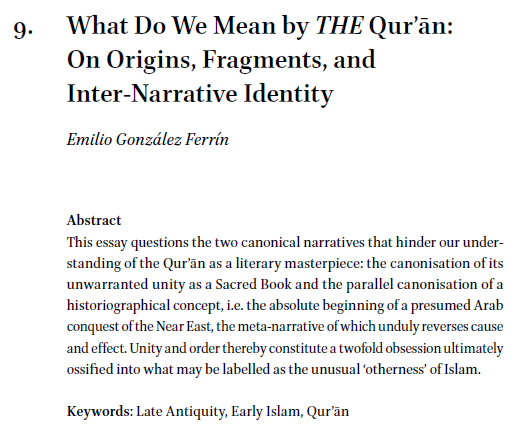
In vocalized Kufic Qurans, as a rule only 3 things are consistently marked: hamzah, final short vowels, and ʾiʿrāb. Tanwīn is marked by writing the ʾiʿrāb twice. Occasionally the indefinite accusative is missing, e.g. ḥanīfan musliman. I figured out why! 🧵 

Taking the Quran of Amajur as our base, we can make a list of places where the tanwīn is used, and places where it isn't. Let's also make note of the word that follows (that will become important).
Without dots:
-ʾarbāban (min)
-yahūdiyyan (lā)
-naṣrāniyyan (walākin)

Without dots:
-ʾarbāban (min)
-yahūdiyyan (lā)
-naṣrāniyyan (walākin)


Without dots:
-ḥanīfan (musliman)
-musliman (wa)
-ṯamanan (qalīlan)
-farīqan (yalwūna)
-dīnan (fa-lan)



-ḥanīfan (musliman)
-musliman (wa)
-ṯamanan (qalīlan)
-farīqan (yalwūna)
-dīnan (fa-lan)




With dots:
- baʿḍan (ʾarbāban)
- qalīlan (ʾulāʾika)
- ʾarbāban (ʾa-)
Last one without dots:
Without dots:
- qawman (kafarū)



- baʿḍan (ʾarbāban)
- qalīlan (ʾulāʾika)
- ʾarbāban (ʾa-)
Last one without dots:
Without dots:
- qawman (kafarū)




A final interesting one is šayʾan wa, which indeed lacks the tanwīn, but does have a single red dot for the hamzah. This also proves that this system is not simply the result of forgetful scribes failing to write dots on the ʾalif! 

Anyone who knows their taǧwīd may have figured it out already: The dots are only written when there is no ʾiḫfāʾ or ʾidġām!
For those who don't know their taǧwīd, let me explain:
Whenever word-final nūn or tanwīn comes in contact with a following consonant it undergoes change:
For those who don't know their taǧwīd, let me explain:
Whenever word-final nūn or tanwīn comes in contact with a following consonant it undergoes change:
Next to some consonants it completely assimilates:
ḥanīfan musliman > ḥanīfam=musliman
yahūdiyyan lā > yahudiyal=lā
With semi-vowels it assimilates completely with nasalization:
šayʾan wa > šayʾaw̃=wa
farīqaỹ=yalwūna.
ḥanīfan musliman > ḥanīfam=musliman
yahūdiyyan lā > yahudiyal=lā
With semi-vowels it assimilates completely with nasalization:
šayʾan wa > šayʾaw̃=wa
farīqaỹ=yalwūna.
But the vast majority of the consonants undergoes place of articulation assimilation, very similar to many other languages of the world. This is called ʾiḫfāʾ:
ṯamanaɴ=qalīlan
dīnaɱ=fa-lan
There are a few consonant that don't do ʾiḫfāʾ: ḫāʾ, ġayn, ḥāʾ, ʿayn, hamz (ʾ), hāʾ.
ṯamanaɴ=qalīlan
dīnaɱ=fa-lan
There are a few consonant that don't do ʾiḫfāʾ: ḫāʾ, ġayn, ḥāʾ, ʿayn, hamz (ʾ), hāʾ.
And indeed in the examples above, whenever a hamzah followed the tanwīn, the tanwīn was written!
baʿḍan ʾarbāban
qalīlan ʾulāʾika
ʾarbāban ʾa-
(Among the canonical readers, ʾAbū Ǧaʿfar also does ʾiḫfāʾ with ḫ and ġ).
baʿḍan ʾarbāban
qalīlan ʾulāʾika
ʾarbāban ʾa-
(Among the canonical readers, ʾAbū Ǧaʿfar also does ʾiḫfāʾ with ḫ and ġ).
So this practice of leaving out the dots on tanwīn-ʾalif is a very subtle, but efficient way of marking that the tanwīn undergoes ʾiḫfāʾ or ʾidġām.
This is only used for the accusative, not for the nominative or genitive, e.g.:
ʿalīmum=bi-l-mufsidīna
bi-qinṭāriỹ=yuʾaddihū

This is only used for the accusative, not for the nominative or genitive, e.g.:
ʿalīmum=bi-l-mufsidīna
bi-qinṭāriỹ=yuʾaddihū


So why did vocalizers only make the distinction with the indefinite accusative? I think because the indefinite accusative is orthographically marked in the rasm. It is followed by an ʾalif, so even without dots, it is clearly an accusative.
On the other hand, the nominative and genitive could not be distinguished if you would remove the dots. So here the dotters decided to write the tanwīn, despite its assimilated pronunciation.
Not all vocalizers do this, I don't believe al-Dānī describes it at all.
Not all vocalizers do this, I don't believe al-Dānī describes it at all.
But Ibn al-Sarrāj (reporting from al-Yazīdī (d. 202 AH), THAT transmitter of ʾAbū ʿAmr!) does describe this practice, and he gives eactly the explanation that I just gave! So, as is typical with the islamic tradition, my discovery just reinvented the wheel. 



Still it is good to see that the descriptions that show up in these medieval sources are actually found in manuscripts. In my previous thread I looked at a practice described by al-Dānī which, so far, has not been found in any real manuscripts at all.
https://twitter.com/PhDniX/status/1350051420410687488
If you enjoyed this thread and want me to do more of it, please consider buying me a coffee.
ko-fi.com/phdnix.
If you want to support me in a more integral way, you can become a patron on Patreon!
patreon.com/PhDniX
ko-fi.com/phdnix.
If you want to support me in a more integral way, you can become a patron on Patreon!
patreon.com/PhDniX
• • •
Missing some Tweet in this thread? You can try to
force a refresh















